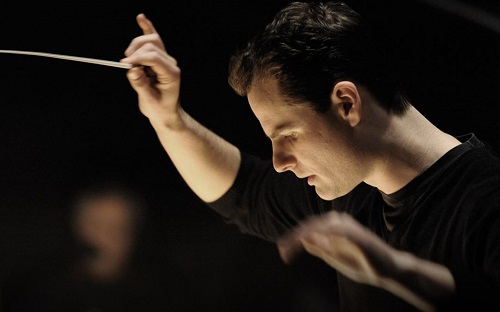 Canada Wagner, Bruch, Schubert: Sarah Chang (violin), Vancouver Symphony Orchestra / Constantin Trinks (conductor), Orpheum Theatre, Vancouver, 28.4.2018. (GN)
Canada Wagner, Bruch, Schubert: Sarah Chang (violin), Vancouver Symphony Orchestra / Constantin Trinks (conductor), Orpheum Theatre, Vancouver, 28.4.2018. (GN)

Wagner – Lohengrin: Prelude to Act I
Bruch – Violin Concerto No.1 in G minor Op.26
Schubert – Symphony No.9 in C major D.944 ‘Great’
Young German maestro Constantin Trinks impressed greatly last year when he stepped in to conduct the VSO at short notice for Pietari Inkinen and elicited a strong response from the orchestra in Dvořák and Prokofiev (review). The same level of artistry was confirmed in this concert which featured Wagner and Schubert’s challenging ‘Great’ C major Symphony, with violinist Sarah Chang contributing the Bruch concerto. Trinks seems to secure fine discipline and a transparent balance in whatever he conducts, but it is his natural musical understanding and keen dramatic sense that make his performances special. The Schubert was undoubtedly the finest we have seen here for years. Sarah Chang aimed at some interesting extremes in the Bruch concerto though executional deficiencies let the interpretation down a degree.
Trinks’ love of Wagner came across at the beginning of the concert in the famous Prelude to Lohengrin. The high strings were tenderly shaped at the opening, creating just the type of inward restraint to permit a real opening out when the lower strings entered. A lovely engulfing flow was in place as the defining cymbal-crash approached, winding down with the right type of quiet glow thereafter. Throughout, the violins made a real effort to find the correct ethereal sheen and refinement, even if they could have gone further still.
He provided attentive and structurally cogent conducting in the Bruch Violin Concerto but Sarah Chang seemed to have some different ideas, not seeking out the work’s usually serene and noble lyrical arch. In the opening movement, she entered slowly and quietly, soon springing forth with surges of passion, making the journey more emotionally volatile. It is an interesting approach, except that it was difficult to tell whether it was she or the work that was generating the unsettled quality. Her intonation was occasionally suspect, and her thinness of tone and vagaries in execution did not help make the proceedings ingratiating. The violinist climbed very slowly out of the mists again in the Adagio and, while her lyrical outreach could be quite beautiful, traces of sentimentality crept in. The conductor set a rhythmically powerful fabric for Chang to work with in the rollicking finale, and this drew the violinist to her best playing, more natural in line and more spontaneous in feeling, finding fine thrust and surges of joy throughout. Chang has undoubtedly played this work so many times that she is searching for something new, but it would be difficult to say she fully realized it here.
It is always a major challenge for a young conductor and orchestra to take on Schubert’s long Ninth Symphony (even longer when all its repeats are taken, as here), yet Trinks’ performance was the most distinguished we have seen for years. It maintained a direct line through the work, always managing to fuse rhythmic strength and drama with beguiling lyricism and rusticity. One of the pleasures of this performance was hearing the orchestra coaxed into a Gewandhaus-like sound, rich and burnished at the bottom end with the obligato contributions from the horns and trombones very conspicuous. It was also interesting to see the horns (on the left) set up closer to the conductor than the woodwinds.
The flowing tempo for the opening horn theme was well-nigh perfect, and it was redeeming to hear the tender responses in the strings, particularly the cellos. The transition to the main Allegro was seamless, and the tightness of the ensuing rhythms ensured the appropriate bucolic vigour. The only thing that might have been more cleanly etched were the bubbling winds which were slightly vague at points. Climaxes were typically put in place by a slight accelerando, but they always achieved the right adrenalin flow and sweep, then settling back to their rustic origins as they should. Time and again one noticed how the conductor separated the different orchestral choirs, often giving cutting emphasis to a middle string voice to push the line of the music forward with frisson. The first movement built supremely well, and it was a virtue that there was no slowing for the restatement of the main theme at the end.
The jaunty tread of the Andante was put in place with rhythmic certitude, but Trinks was sensitive to the moments of tender lyrical flowering too, consistently finding emotional resonance and eloquence in the string lines. This was particularly noticeable in the heavenly expression after the central climax, which had a natural glow and ardour, with details falling perfectly into place. The rustic nature of the Scherzo was highlighted, taken at a fairly quick pace but with fine rhythmic push and an appropriate plasticity in the string line – and with perhaps a hint of Bruckner hovering over it all. The finale moved home splendidly, with telling rustic detail, sprung rhythms and a true grip and majesty at the end, giving an enviable sense of cohesion to a work that can easily become sprawling in lesser hands.
Overall, Trinks’ control of the varying intensities needed in this long work was a tour-de-force and, discounting a few technical vagaries in the winds and horns, the orchestra did itself proud. The conductor’s tensile strength and sense of integrated motion reminded me of an estimable performance of the past that now receives less attention than it might – namely, that of Otmar Suitner.
I would welcome visits from this maestro on a recurring basis. He seems to challenge the orchestra to do things that they might not otherwise attempt and gets absolutely inspired results.
Geoffrey Newman
Previously published in a slightly different form on http://www.vanclassicalmusic.com.